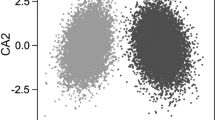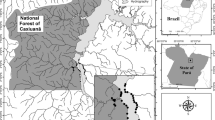Abstract
Crayfish are major herbivores in freshwaters, and their activity may change invaded freshwater ecosystems. Macrophyte removal by crayfish results from consumption and fragmentation of plant material and may depend upon the palatability of each species. We studied the impact of Procambarus clarkii on the macrophyte community of Mediterranean temporary ponds, testing in laboratory if consumption and fragmentation of five macrophyte species were correlated in palatability tests and in a preference test. We performed an experiment in a natural pond, where we introduced crayfish and estimated its effects on macrophyte biomass, number of rooted stalks and number of floating cut stalks. P. clarkii consumed preferably Juncus heterophyllus in both tests and avoided Carex divisa and Ranunculus peltatus in the preference test. In the presence of preferred species, consumption and fragmentation of the non-preferred species were heavily reduced. In the field trial, the “Crayfish” compartment had 31% less macrophyte biomass, 41% less rooted stalks and 92% more floating cut stalks. Crayfish may remove macrophyte species from the community sequentially, from the most to the least preferred species. Impacts of crayfish in temporary ponds may depend on time of invasion and on the composition of the macrophyte community.


Similar content being viewed by others
References
Alcorlo, P., W. Geiger & M. Otero, 2004. Feeding preferences and food selection of the red swamp crayfish, Procambarus clarkii, in habitats differing in food item diversity. Crustaceana 77: 435–453.
Anastácio, P. M., A. M. Correia & J. P. Menino, 2005. Processes and patterns of plant destruction by crayfish: effects of crayfish size and developmental stages of rice. Archiv für Hydrobiologie 162: 37–51.
Avault, J. W. Jr., R. P. Romaire & M. R. Miltner, 1981. Feeds and forages for red swamp crawfish, Procambarus clarkii: 15 years research at Louisiana State University. Proceedings of the International Symposium of Freshwater Crayfish 5: 362–369.
Cambray, J. A., 2003. Impact on indigenous species biodiversity caused by the globalization of alien recreational freshwater fisheries. Hydrobiologia 500: 217–230.
Charlebois, P. M. & G. A. Lamberti, 1996. Invading crayfish in a Michigan stream: direct and indirect effects on periphyton and macroinvertebrates. Journal of the North American Benthological Society 15: 551–563.
Correia, A. M., 2002. Niche breadth and trophic diversity: feeding behaviour of the red swamp crayfish (Procambarus clarkii) towards environmental availability of aquatic macroinvertebrates in a rice field (Portugal). Acta Oecologica 23: 421–429.
Creed, R. P. Jr. & J. M. Reed, 2004. Ecosystem engineering by crayfish in a headwater stream community. Journal of the North American Benthological Society 23: 224–236.
Crehuet, M., P. Alcorlo, M. A. Bravo-Utrera, A. Baltanás & C. Montes, 2007. Assessing the trophic ecology of crayfish: a case study of the invasive Procambarus clarkii. In Gherardi F. (ed.), Biological Invaders in Inland Waters: Profiles, Distributions and Threats, Vol. 2. Invading Nature—Springer Series in Invasion Ecology, Springer, Dordrecht: 559–576.
Cronin, G., D. M. Lodge, M. E. Hay, M. Miller, A. M. Hill, T. Horvath, R. C. Bolser, N. Lindquist & M. Wahl, 2002. Crayfish feeding preferences for freshwater macrophytes: the influence of plant structure and chemistry. Journal of Crustacean Biology 22: 708–718.
Cruz, M. J., P. Andrade, S. Pascoal & R. Rebelo, 2004. Colonization of temporary ponds by the red swamp crayfish, Procambarus clarkii (in Portuguese). Revista de Biologia (Lisboa) 22: 79–90.
Cruz, M. J. & R. Rebelo, 2005. Vulnerability of Southwest Iberian amphibians to an introduced crayfish, Procambarus clarkii. Amphibia-Reptilia 26: 293–303.
Cruz, M. J., R. Rebelo & E. G. Crespo, 2006a. Effects of an introduced crayfish, Procambarus clarkii, on the distribution of south-western Iberian amphibians in their breeding habitats. Ecography 29: 329–338.
Cruz, M. J., S. Pascoal, M. Tejedo & R. Rebelo, 2006b. Predation by an exotic crayfish, Procambarus clarkii, on natterjack toad, Bufo calamita, embryos: its role on the exclusion of this amphibian from its breeding ponds. COPEIA 2006: 274–280.
Cuttelod, A., N. García, D. A. Malak, H. Temple & V. Katariya, 2008. The Mediterranean: a biodiversity hotspot under threat. In Vié, J. C., C. Hilton-Taylor & S. N. Stuart (eds), The 2008 Review of The IUCN Red List of Threatened Species. IUCN Gland, Switzerland.
Elger, A., N. J. Willby & M. Cabello-Martinez, 2009. Invertebrate grazing during the regenerative phase affects the ultimate structure of macrophyte communities. Freshwater Biology 54: 1246–1255.
Flinders, C. A. & D. D. Magoulick, 2007. Effects of depth and crayfish size on predation risk and foraging profitability of a lotic crayfish. Journal of the North American Benthological Society 26: 767–778.
Gamradt, S. C. & L. B. Kats, 1996. Effect of introduced crayfish and mosquito fish on California newts (Taricha torosa). Conservation Biology 10: 1155–1162.
García-Berthou, E., C. Alcaraz, Q. Pou-Rovira, L. Zamora, G. Coenders & C. Feo, 2005. Introduction pathways and establishment rates of invasive aquatic species in Europe. Canadian Journal of Fisheries and Aquatic Sciences 62: 453–463.
Geiger, W., P. Alcorlo, A. Baltanás & C. Montes, 2005. Impact of an introduced crustacean on the trophic webs of Mediterranean wetlands. Biological Invasions 7: 49–73.
Gherardi, F., 2008. Procambarus clarkii alien species fact sheet. In Gollasch, S., I. G. Cowx & A. D. Nunn (eds), Environmental Impacts of Alien Species in Aquaculture. IMPASSE. Project Nr. 44142. European Commission Sixth Framework Programme (2002–2006): 38–49.
Gherardi, F. & P. Acquistapace, 2007. Invasive crayfish in Europe: the impact of Procambarus clarkii on the littoral community of a Mediterranean lake. Freshwater Biology 52: 1249–1259.
Gherardi, F. & S. Barbaresi, 2008. Feeding opportunism of the red swamp crayfish, Procambarus clarkii, and invasive species. Freshwater Crayfish 16: 77–85.
Guan, R. Z., 1997. An improved method for marking crayfish. Crustaceana 70: 641–652.
Hidding, B., B. A. Nolet, T. de Boer, P. P. de Vries & M. Klaassen, 2010. Above- and below-ground vertebrate herbivory may each favour a different subordinate species in an aquatic plant community. Oecologia 162: 199–208.
Hirsch, P. E., 2009. Freshwater crayfish invasions: former crayfish invader Galician crayfish hands title invasive over to new invader spiny-cheek crayfish. Biological Invasions 11: 515–521.
Hulbert, S. H., 1984. Pseudoreplication and the design of ecological field experiments. Ecological Monographs 54: 187–211.
Ilhéu, M. & J. M. Bernardo, 1993. Experimental evaluation of food preference of red swamp crayfish, Procambarus clarkii: vegetal versus animal. Freshwater Crayfish 9: 359–364.
Jackson, A. C. & A. J. Underwood, 2007. Application of new techniques for the accurate analysis of choice of prey. Journal of Experimental Marine Biology and Ecology 341: 1–9.
Kats, L. B. & R. P. Ferrer, 2003. Alien predators and amphibian declines: review of two decades of science and the transition to conservation. Diversity and Distributions 9: 99–110.
Leberfinger, K. & I. Bohman, 2010. Grass, mosses, algae, or leaves? Food preference among shredders from open-canopy streams. Aquatic Ecology 44: 195–203.
Lodge, D. M., R. A. Stein, K. M. Brown, A. P. Covich, C. Bronmark, J. E. Garvey & S. P. Klosiewski, 1998. Predicting impact of freshwater exotic species on native biodiversity: challenges in spatial scaling. Australian Journal of Ecology 23: 53–67.
Lodge, D. M., C. A. Taylor, D. M. Holdich & J. Skurdal, 2000. Nonindigenous crayfishes threaten North American freshwater biodiversity: lessons from Europe. Fisheries 25: 7–20.
Manly, B., 1997. Randomization and Monte Carlo Methods in Biology, 2nd ed. Chapman & Hall, London.
Matsuzaki, S. S., N. Usio, N. Takamura & I. Washitani, 2009. Contrasting impacts of invasive engineers on freshwater ecosystems: an experiment and meta-analysis. Oecologia 158: 673–686.
Núñez, D. R. & C. O. Castro, 1991. La Guía de INCAFO de las plantas utiles y venenosas de la Peninsula Ibérica y Baleares. INCAFO, Madrid.
Nyström, P. & J. A. Strand, 1996. Grazing by a native and an exotic crayfish on aquatic macrophytes. Freshwater Biology 36: 673–682.
Oertli, B., J. Biggs, R. Céréghino, P. Grillas, P. Joly & J. B. Lachavanne, 2005. Conservation and monitoring of pond biodiversity: introduction. Aquatic Conservation: Marine and Freshwater Ecosystems 15: 535–540.
R Development Core Team, 2010. R: A Language and Environment for Statistical Computing. R Foundation for Statistical Computing, Vienna.
Rodríguez, C. L., E. Bécares & M. Fernández-Aláez, 2003. Shift from clear to turbid phase in Lake Chozas (NW Spain) due to the introduction of American red swamp crayfish (Procambarus clarkii). Hydrobiologia 506–509: 421–426.
Rodríguez, C. F., E. Bécares, M. Fernández-Aláez & C. Fernández-Aláez, 2005. Loss of diversity and degradation of wetlands as a result of introducing exotic crayfish. Biological Invasions 7: 75–85.
Ruiz, E., 2008. Management of Natura 2000 habitats. 3170 *Mediterranean temporary ponds. European Commission.
Sala, O. E., F. S. Chapin, J. J. Armesto, E. Berlow, J. Bloompeld, R. Dirzo, E. Huber-Sanwald, L. F. Huenneke, R. B. Jackson, A. Kinzig, R. Leemans, D. M. Lodge, H. A. Mooney, M. Oesterheld, N. L. Poff, M. T. Sykes, B. H. Walker, M. Walker & D. H. Wall, 2000. Global biodiversity scenarios for the year 2100. Science 287: 1770–1774.
Saunders, D. L., J. J. Meeuwig & C. J. Vincent, 2002. Freshwater protected areas: strategies for conservation. Conservation Biology 16: 30–41.
Torralba-Burrial, A., F. J. O. Larrondo, A. C. Rivera, D. Outomuro & P. M. A. Amorín, 2011. Coenagrion scitulum (Rambur, 1842). In Verdú, J. R., C. Y. Numa & E. Galante (eds), Atlas y Libro Rojo de los Invertebrados amenazados de España (Especies Vulnerables). Dirección General de Medio Natural y Política Forestal, Ministerio de Medio Ambiente, Medio rural y Marino, Madrid: 540–550.
Van Nes, E. H. & M. Scheffer, 2002. Alternative attractors may boost uncertainty and sensitivity in ecological models. Ecological Modelling 159: 117–124.
Vives, P. T. (ed.), 1996. Monitoring Mediterranean Wetlands: A Methodological Guide. MedWet Publication. Wetlands International, Slimbridge and ICN, Lisbon.
Acknowledgments
This study was financed by FCT—Fundação para a Ciência e Tecnologia (Portugal) through Financiamento Plurianual to Rui Rebelo and was accomplished in the facilities of the field station of Centro de Biologia Ambiental in Herdade da Ribeira Abaixo (Grândola). Bruno Carreira benefited from a doctoral fellowship from FCT (SFRH/BD/80341/2011) and Maria Dias benefited from postdoctoral fellowship from FCT (BPD/46827/08). The authors also thank the reviewers for the comments and suggestions that greatly improved the quality of the manuscript.
Author information
Authors and Affiliations
Corresponding author
Additional information
Handling editor: Katya E. Kovalenko
Electronic supplementary material
Below is the link to the electronic supplementary material.
Rights and permissions
About this article
Cite this article
Carreira, B.M., Dias, M.P. & Rebelo, R. How consumption and fragmentation of macrophytes by the invasive crayfish Procambarus clarkii shape the macrophyte communities of temporary ponds. Hydrobiologia 721, 89–98 (2014). https://doi.org/10.1007/s10750-013-1651-1
Received:
Revised:
Accepted:
Published:
Issue Date:
DOI: https://doi.org/10.1007/s10750-013-1651-1




